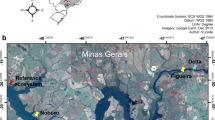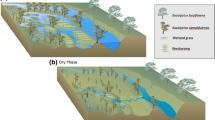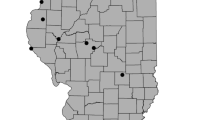Abstract
Successful wetland restoration depends on the development of the vegetation community post-restoration. Woody vegetation provides functional and structural support to the wetland ecosystem and community development post-restoration dictates restoration outcomes. We investigated basal area, stem density, and species richness of woody vegetation in 40 restored wetlands across West Virginia, USA, ranging in age from 1 to 29 years post-restoration. We aggregated field-collected data into eight indicators at the site scale and investigated stem size distribution to describe the overall woody vegetation community. Generalized linear regression shows native species richness slightly declined as wetland site age increased. In contrast, the total basal area increased over time since restoration. Total stem density did not vary by age. Regardless of age, all sites were dominated by woody vegetation with a stem diameter < 9.1 cm, whereas the frequency of stems > 9.1 cm increased as wetland age increased. This study demonstrates that the development of woody vegetation post-restoration occurs over decades in central Appalachian wetlands and shows the diverse conditions between restoration sites.





Similar content being viewed by others
Data Availability
The datasets generated during and/or analyzed during the current study are available from the corresponding author on reasonable request.
References
Adamus P, Brandt K (1990) Impacts on quality of inland wetlands of the United States: a survey of indicators, techniques, and applications of community-level biomonitoring data. Environmental Protection Agency, Washington, D.C. EPA/600/3–90/073 (NTIS PB91113837).
Alameda D, Villar R (2009) Moderate soil compaction: implications on growth and architecture in seedlings of 17 woody plant species. Soil Tillage Res 103:325–331. https://doi.org/10.1016/j.still.2008.10.029
Allen JA (1997) Reforestation of bottomland hardwoods and the issue of woody species diversity. Restor Ecol 5:125–134. https://doi.org/10.1046/j.1526-100X.1997.09715.x
American Society of Agricultural Engineers (1999) Soil cone penetrometer. ASAE S313.3 (R2018), St. Joseph, MI. https://elibrary.asabe.org/pdfviewer.aspx?GUID=0B92E720-9285-4CA9-BF4F-FD22F9FF0076
Anderson CJ, Mitsch WJ (2008) Tree basal growth response to flooding in a bottomland hardwood forest in central Ohio. J Am Water Resour Assoc 44:1512–1520.https://doi.org/10.1111/j.1752-1688.2008.00255.x
Anderson JT, Zilli FL, Montalto L, Marchese MR, McKinney M, Park YL (2013) Sampling and processing aquatic and terrestrial invertebrates in wetlands. In: Anderson JT, Davis CA (eds) Wetland Techniques. Volume 2: organisms. Springer, New York, New York, pp 142–195
U. S. Army Corps of Engineers (USACE), and U.S. Environmental Protection Agency (USEPA) (2008) Compensatory Mitigation for Losses of Aquatic Resources. Federal Register 73(70) https://www.ecfr.gov/current/title-40/chapter-I/subchapter-H/part-230/subpart-J
Atkinson RB, Perry JE, Smith E, Cairns J Jr (1993) Use of created wetland delineation and weighted averages as a component of assessment. Wetlands 13:185–193. https://doi.org/10.1007/BF03160879
Bailey DE, Perry JE, Daniel WL (2007) Vegetation dynamics in response to organic matter loading rates in a created freshwater wetland in southeastern Virginia. Wetlands 27:936–950. https://doi.org/10.1672/0277-5212(2007)27[936:VDIRTO]2.0.CO;2
Balcombe CK, Anderson JT, Fortney RH, Kordek WS (2005a) Vegetation, invertebrate, and wildlife community rankings and habitat analysis of mitigation wetlands in West Virginia. Wetl Ecol and Manag 13:517–530. https://doi.org/10.1007/s11273-004-5074-7
Balcombe CK, Anderson JT, Fortney RH, Kordek WS (2005b) Wildlife use of mitigation and reference wetlands in West Virginia. Ecol Eng 25:85–99. https://doi.org/10.1016/j.ecoleng.2005.03.003
Balcombe CK, Anderson JT, Fortney RH, Kordek WS (2005c) Aquatic macroinvertebrate assemblages in mitigated and natural wetlands. Hydrobiologia 541:175–188. https://doi.org/10.1007/s10750-004-5706-1
Balcombe CK, Anderson JT, Fortney RH, Rentch JS, Grafton NW, Kordek WS (2005d) A comparison of wetland plant communities in mitigation and reference wetlands in the Mid-Appalachians. Wetlands 25:130–142. https://doi.org/10.1672/0277-5212(2005)025[0130:ACOPCI]2.0.CO;2
Bell JL, Boyer JN, Crystall SJ, Nichols WF, Pruyn M (2017) Floristic quality as an indicator of human disturbance in forested wetlands of northern New England. Ecol Indic 83:227–231. https://doi.org/10.1016/j.ecolind.2017.08.010
BenDor T, Sholtes J, Doyle MW (2009) Landscape characteristics of a stream and wetland mitigation banking program. Ecol Appl 19:2078–2092. https://doi.org/10.1890/08-1803.1
Berkowitz JF (2013) Development of restoration trajectory metrics in reforested bottomland hardwood forests applying a rapid assessment approach. Ecol Indic 34:600–606. https://doi.org/10.1016/j.ecolind.2013.06.025
Berkowitz JF (2019) Quantifying functional increases across a large-scale wetland restoration chronosequence. Wetlands 39:559–573. https://doi.org/10.1007/s13157-018-1103-9
Bledsoe BP, Shear TH (2000) Vegetation along hydrologic and edaphic gradients in a North Carolina coastal plain creek bottom and implications for restoration. Wetlands 20:126–147. https://doi.org/10.1672/0277-5212(2000)020[0126:VAHAEG]2.0.CO;2
Bonner JL, Anderson JT, Rentch JS, Grafton NW (2009) Vegetative composition and community structure associated with beaver ponds in Canaan Valley, West Virginia, USA. Wetl Ecol Manag 17:543–554. https://doi.org/10.1007/s11273-009-9131-0
Brown SC, Veneman PL (2001) Effectiveness of compensatory wetland mitigation in Massachusetts. USA Wetlands 21(4):508–518. https://doi.org/10.1672/0277-5212(2001)021[0508:EOCWMI]2.0.CO;2
Bryzek JA (2022) Wetland mitigation performance standards: The intersection of science, practice, and policy. Thesis, West Virginia University
Bryzek JA, Noe KL, De Silva S, MacKenzie A, Von Haugg CL, Hartman D, McCall JE, Veselka IVW, Anderson JT (2022) Obligations of researchers and managers to respect wetlands: practical solutions to minimizing field monitoring impacts. Land 11:481. https://doi.org/10.3390/land11040481
Callaway JC, Sullivan G, Zedler JB (2003) Species-rich plantings increases biomass and nitrogen accumulation in a wetland restoration experiment. Ecol Appl 13:1626–1639. https://doi.org/10.1890/02-5144
Campbell DA, Cole CA, Brooks RP (2002) A comparison of created and natural wetlands in Pennsylvania, USA. Wetl Ecol Manag 10(1):41–49. https://doi.org/10.1023/A:1014335618914
Cherefko C, Fridley C, Medsger J, Woody M, Anderson JT (2015) White-tailed deer and balsam woolly adelgid effects on balsam fir in Canaan Valley. Southeast Nat 14(sp 7):218–231. https://doi.org/10.1656/058.014.sp719
Clipp HL, Anderson JT (2014) Environmental and anthropogenic factors influencing salamanders in riparian forests: a review. Forests 5:2679–2702. https://doi.org/10.3390/f5112679
Cole CA, Shafer D (2002) Sect. 404 wetland mitigation and permit success criteria in Pennsylvania, USA, 1986–1999. Environ Manage 30:508–515. https://doi.org/10.1007/s00267-002-2717-4
Conner WH, Day JW Jr (1992) Diameter growth of Taxodium distichum (L.) Rich. And Nyssa aquatica L. from 1979–1985 in four Louisiana swamp stands. Am Midl Nat 127(2):290–299. https://doi.org/10.2307/2426535
Cooper DJ, Kacynski KM, Sueltenfuss J, Gaucherand S, Hazen C (2017) Mountain wetland restoration: the role of hydrologic regime in plant introductions after 15 years in the Colorado Rocky Mountains, U.S.A. Ecol Eng 101:46–59. https://doi.org/10.1016/j.ecoleng.2017.01.017
Cowardin LM, Carter V, Golet FC, LaRoe ET Classification of wetland and deepwater habitats of the United States. FWS/OBS-79/31. U. S. Fish and Wildlife Service, Washington DC (1979) USA. https://files.dnr.state.mn.us/lands_minerals/northmet/permit_to_mine/wrp/08_cowardin_et_al_1979_classification_of_wetlands.pdf
D’Angelo EM, Karathanasis AD, Sparks EJ, Ritchey SA, Wehr-McChesney SA (2005) Soil carbon and microbial communities at mitigated and late successional bottomland forest wetlands. Wetlands 25:162–175. https://doi.org/10.1672/0277-5212(2005)025[0162:SCAMCA]2.0.CO;2
Davidson SJ, Dazé E, Byun E, Hiler D, Kangur M, Talbot J, Finkelstein SA, Strack M (2022). The unrecognized importance of carbon stocks and fluxes from swamps in Canada and the USA. Environ Res Lett 17 053003https://doi.org/10.1088/1748-9326/ac63d5/meta
DeBerry DA (2020) Vegetation sampling concepts for compensatory mitigation sites. Wet Sci Pract 37:174–182
DeBerry DA, Perry JE (2004) Primary succession in a created freshwater wetland. Castanea 69:185–193. https://doi.org/10.2179/0008-7475(2004)0690185:PSIACF2.0.CO;2
DeBerry DA, Perry JE (2012) Vegetation dynamics across a chronosequence of created wetland sites in Virginia, USA. Wetl Ecol Manag 20:521–537. https://doi.org/10.1007/s11273-012-9273-3
Diamond JS, McLaughlin DL, Slesak RA, Stovall A (2019) Pattern and structure of microtopography implied autogenic origins in forested wetlands. Hydrol Earth Syst Sci 23:5069–5088. https://doi.org/10.5194/hess-23-5069-2019
Flaherty KL, Rentch JS, Grafton WN, Anderson JT (2018) Timing of white-tailed deer browsing affects wetland plant communities. Plant Ecol 219:313–324. https://doi.org/10.1007/s11258-018-0797-3
Gomez-Aparicio L (2009) The role of plant interactions in the restoration of degraded ecosystems: a meta-analysis across life-forms and ecosystems. J Ecol 97:1202–1214. https://doi.org/10.1111/j.1365-2745.2009.01573.x
Gotelli NJ, Ellison AM (2004) A primer of ecological statistics, vol 1. Sinauer Associates, Sunderland
Gwin SE, Kentula ME, Shaffer PW (1999) Evaluating the effects of wetland regulation through hydrogeomorphic classification and landscape profiles. Wetlands 19:477–489. https://doi.org/10.1007/BF03161687
Haskell D, Flaspohler EDJ, Webster CR, Meyer MW (2012) Variation in soil temperature, moisture, and plant growth on lakeshore restoration sites. Rest Ecol. https://doi.org/10.1111/j.1526-100X.2010.00730.x. 20113-121
Heitmeyer M, Fredrickson L, Laubhan M, Nelson F, Pogue G, Helmers D, King W (2013) Wetland design and development. In: Anderson JT, Davis CA (eds) Wetland Techniques. Volume 3: applications and management. Springer, New York, New York, pp 69–120
Hough P, Robertson M (2009) Mitigation under Sect. 404 of the Clean Water Act: where it comes from, what it means. Wetl Ecol Manage 17:15–33. https://doi.org/10.1007/s11273-008-9093-7
Hunter RG, Faulkner SP, Gibson KA (2008) The importance of hydrology in restoration of bottomland hardwood wetland functions. Wetlands 28:605–615. https://doi.org/10.1672/07-139.1
Johnson YB, Shear TH, James AL (2012) Identifying ecohydrological patterns in natural forested wetlands useful to restoration design. Ecohydrol 5:368–379. https://doi.org/10.1002/eco.227
Kozlowski TT (1999) Soil compaction and growth of woody plants. Scand J for Res 14:596–619. https://doi.org/10.1080/02827589908540825
Lichvar RW, Butterwick M, Melvin NC, Kirchner WN (2014) The national wetland plant list: 2014 update of wetland ratings. Phytoneuron 2014–41:1–42. https://cwbi-app.sec.usace.army.mil/nwpl_static/data/DOC/lists_2014/National/National_2014v1.pdf
Lockhart B, Keeland B, McCoy J, Dean T (2003) Comparing regeneration techniques for afforestating previously farmed bottomland hardwood sites in the Lower Mississippi Alluvial Valley, USA. Forestry (Lond) 76:169–180. https://doi.org/10.1093/forestry/76.2.169
Matthews JW, Endress AG (2008) Performance criteria, compliance success, and vegetation development in compensatory mitigation wetlands. Environ Manage 41:130–141. https://doi.org/10.1007/s00267-007-9002-5
Matthews JW, Spyreas G (2010) Convergence and divergence in plant community trajectories as a framework for monitoring wetland restoration progress. J Appl Ecol 47:1128–1136. https://doi.org/10.1111/j.1365-2664.2010.01862.x
Matthews JW, Spyreas G, Endress AG (2009a) Trajectories of vegetation-based indicators used to assess wetland restoration progress. Ecol Appl 19:2093–2107. https://doi.org/10.1890/08-1371.1
Matthews JW, Peralta AL, Flanagan DN, Baldwin PM, Soni A, Kent AD, Endress AG (2009b) Relative influence of landscape vs. local factors on plant community assembly in restored wetlands. Ecol Appl 19:2108–2123. https://doi.org/10.1890/08-1836.1
McCurry JR, Gray MJ, Mercker DC (2010) Early growing season flooding influence on seedlings of three common bottomland hardwood species in western Tennessee. J Fish Wildl Manag 1:11–18. https://doi.org/10.3996/JFWM-015
McLeod KW, Reed MR, Nelson EA (2001) Influence of a willow canopy on tree seedling establishment for wetland restoration. Wetlands 21:395–402. https://doi.org/10.1672/0277-5212(2001)021[0395:IOAWCO]2.0.CO;2
Minnesota Pollution Control Agency (2012) Rapid Floristic Quality Assessment Manual, vol wq–bwm2–02b. Minnesota Pollution Control Agency, St. Paul, MN.https://conservationresearchinstitute.org/files/minnesota_rapid_assessment_manual.pdf
Mitsch WJ, Wilson RF (1996) Improving the success of wetland creation and restoration with know-how, time, and self‐design. Ecol Appl 6:77–83. https://doi.org/10.2307/2269554
Moreno-Mateos D, Meli P, Vara‐Rodríguez MI, Aronson J (2015) Ecosystem response to interventions: lessons from restored and created wetland ecosystems. J Appl Ecol 52:1528–1537. https://doi.org/10.1111/1365-2664.12518
Morgan KL, Roberts TH (2003) Characterization of wetland mitigation projects in Tennessee. USA Wetlands 23:65–69. https://doi.org/10.1672/0277-5212(2003)023[0065:COWMPI]2.0.CO;2
Niswander SF, Mitsch WJ (1995) Functional analysis of a two-year old created in-stream wetland: hydrology, phosphorus retention, and vegetation survival and growth. Wetlands 15:212–225. https://doi.org/10.1007/BF03160701
Pennington MR, Walters MB (2006) The response of planted trees to vegetation zonation and soil redox potential in created wetlands. For Ecol Manag 233:1–10. https://doi.org/10.1016/j.foreco.2006.04.026
Rentch JS, Anderson JT (2006) A floristic quality index for West Virginia wetland and riparian plant communities. West Virginia Agricultural and Forestry Experiment Station Bulletin 730, Morgantown, WV. 65 pages https://researchrepository.wvu.edu/cgi/viewcontent.cgi?article=1620&context=wv_agricultural_and_forestry_experiment_station_bulletins
Robertson M, Galatowitsch SM, Matthews JW (2018) Longitudinal evaluation of vegetation richness and cover at wetland compensation sites: implications for regulatory monitoring under the Clean Water Act. Wetl Ecol Manag 26:1089–1105. https://doi.org/10.1007/s11273-018-9633-8(0123456789().,-volV)(0123456789().,-volV)
Roquemore JD, Hudson HW III, Atkinson RB, Perry JE (2014) Survival and growth of seven tree species from three stocktypes planted in created wetlands in Loudoun County, Virginia. Ecol Eng 64:408–414. https://doi.org/10.1016/j.ecoleng.2014.01.001
Russell KN, Beauchamp VB (2017) Plant species diversity in restored and created Delmarva Bay wetlands. Wetlands 37:1119–1133. https://doi.org/10.1007/s13157-017-0945-x
Shafer DJ, Roberts TH (2007) Long-term development of tidal mitigation wetlands in Florida. Wetl Ecol Manag 16:23–31. https://doi.org/10.1007/s11273-007-9044-8
Spencer DR, Perry JE, Silberhorn GM (2001) Early secondary succession in bottomland hardwood forests of southeastern Virginia. Environ Manage 27:559–570. https://doi.org/10.1007/s002670010170
Spieles DJ (2005) Vegetation development in created, restored, and enhanced mitigation wetland banks of the United States. Wetlands 25:51–63. https://doi.org/10.1672/0277-5212(2005)025[0051:VDICRA]2.0.CO;2
Spyreas G (2016) Scale and sampling effects on floristic quality. PLoS ONE 11:e0160693. https://doi.org/10.1371/journal.pone.0160693
Spyreas G (2019) Floristic quality assessment: a critique, a defense, and a primer. Ecosphere 10:e02825. https://doi.org/10.1002/ecs2.2825
Tiner RW (1996) Current status of West Virginia’s wetlands: results of the national wetland inventory. U.S. Fish and Wildlife Service, Ecological Services, Region 5, Hadley, MA. 44 pp. plus Appendices. https://www.fws.gov/wetlands/Documents//Current-Status-of-West-Virginias-Wetlands.pdf
Walter WD, Godsey LD, Garrett HE, Dwyer JP, Van Sambeek JW, Ellersieck MR (2013) Survival and 14-year growth of black, white, and swamp white oaks established as bareroot and RPM®-containerized planting stock. North J Appl for 30:43–46. https://doi.org/10.5849/njaf.11-047
Wilken E, Nava FJ, Griffith G (2011) North American Terrestrial Ecoregions-Level III. Commission for Environmental Cooperation, Montreal, Canada. http://www.cec.org/files/documents/publications/10415-north-american-terrestrial-ecoregionslevel-iii-en.pdf
Woods AJ, Omernik JM, Brown DD Level III and IV ecoregions of Delaware, Maryland, Pennsylvania, Virginia, and, Virginia W (1999) U.S. Environmental Protection Agency, Corvallis, OR. https://www.nrc.gov/docs/ML0832/ML083220457.pdf
Yingling EL, Keeley CA, Little S, Burtis J Jr (1979) Reducing damage to shade and woodland trees from construction activities. Arboric J 5:97–105
Zedler JB, Callaway JC (1999) Tracking wetland restoration: do mitigation sites follow desired trajectories? Restor Ecol 7:69–73. https://doi.org/10.1046/j.1526-100X.1999.07108.x
Acknowledgements
Funding support was provided by the United States Environmental Protection Agency (Grant # CD-96383001-0). Thanks to the West Virginia Department of Environmental Protection (WVDEP), the Division of Forestry and Natural Resources at West Virginia University, and the James C. Kennedy Waterfowl and Wetlands Conservation Center at Clemson University for additional support. Special thanks to Elizabeth Byers (WVDEP) for her input and guidance. We appreciate the landowners and managers that allowed wetland access.
Funding
This work was supported by the United States Environmental Protection Agency (Grant # CD-96383001-0).
Author information
Authors and Affiliations
Contributions
Walter Veselka IV and James T. Anderson designed the study. Jessica A. Bryzek collected the data. Jessica A. Bryzek and Christopher T. Rota analyzed the data. Jessica A. Bryzek wrote the first draft of the manuscript with substantial input from James T. Anderson. All authors read and approved the final manuscript.
Corresponding author
Ethics declarations
Competing Interests
The authors have no relevant financial or non-financial interests to disclose.
Additional information
Publisher’s Note
Springer Nature remains neutral with regard to jurisdictional claims in published maps and institutional affiliations.
Electronic Supplementary Material
Below is the link to the electronic supplementary material.
Rights and permissions
Springer Nature or its licensor (e.g. a society or other partner) holds exclusive rights to this article under a publishing agreement with the author(s) or other rightsholder(s); author self-archiving of the accepted manuscript version of this article is solely governed by the terms of such publishing agreement and applicable law.
About this article
Cite this article
Bryzek, J.A., Veselka IV, W., Rota, C.T. et al. Woody Vegetation Indicators vary with time Since Wetland Restoration. Wetlands 43, 89 (2023). https://doi.org/10.1007/s13157-023-01735-x
Received:
Accepted:
Published:
DOI: https://doi.org/10.1007/s13157-023-01735-x




